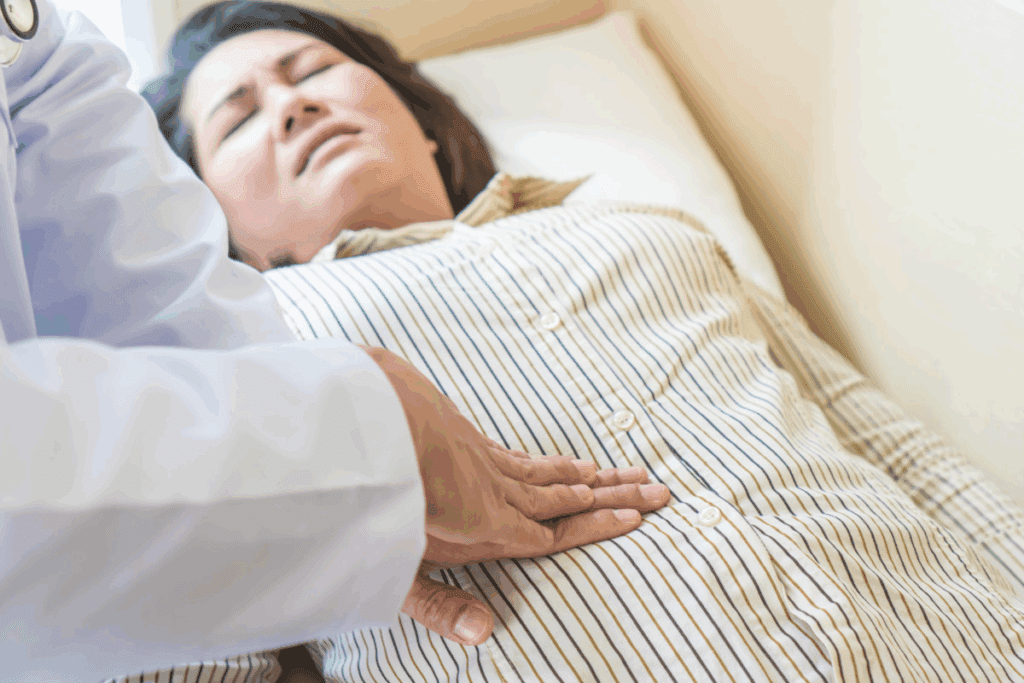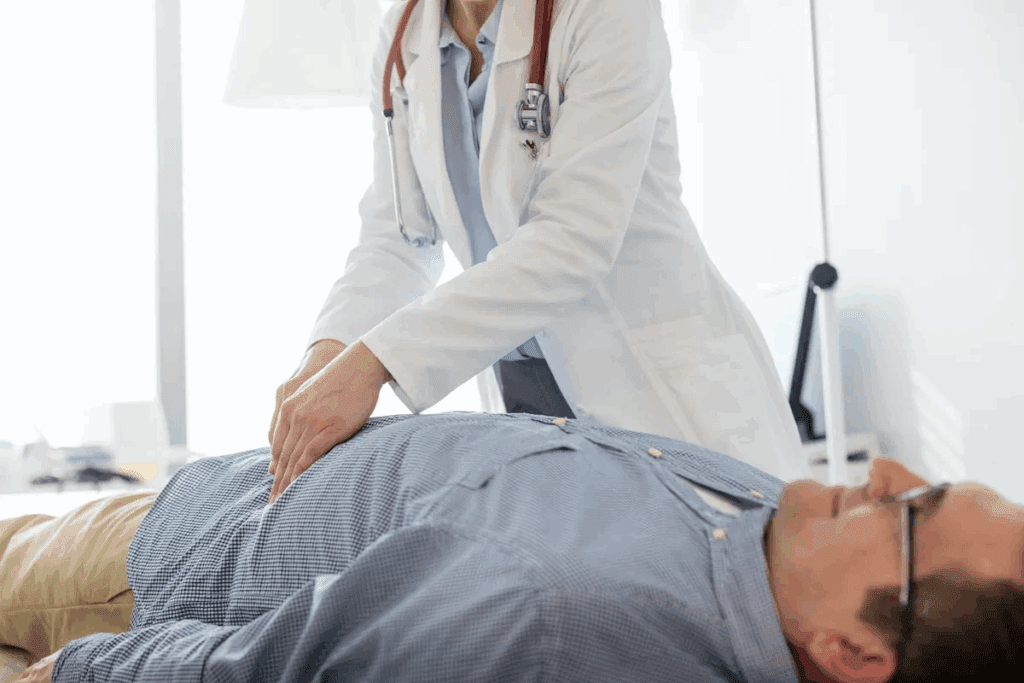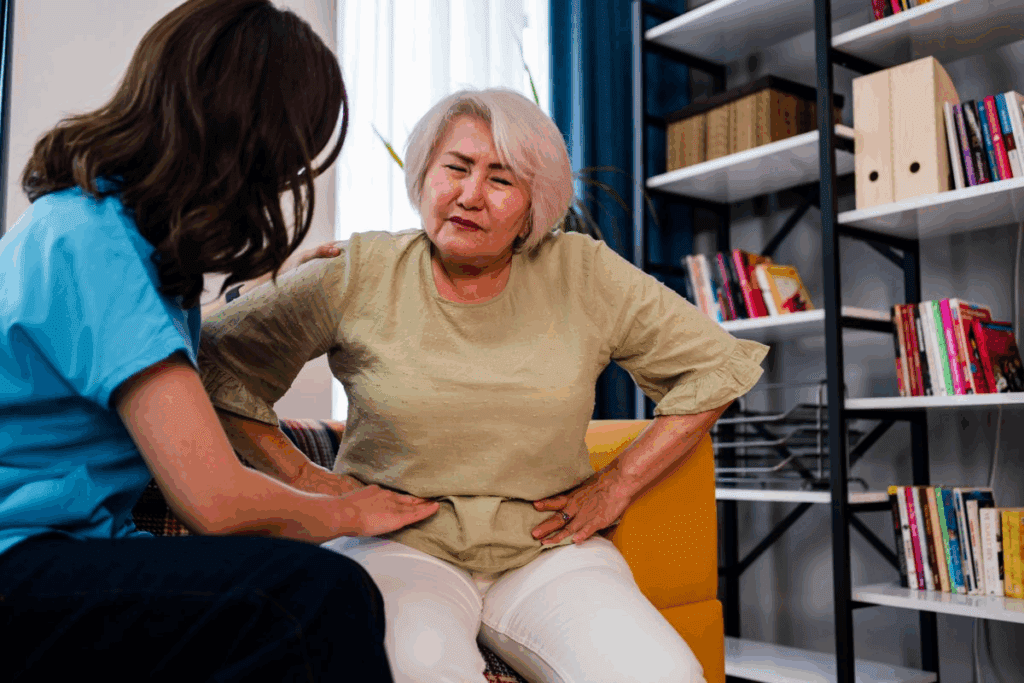Last Updated on November 26, 2025 by Bilal Hasdemir

Learn about fat containing left inguinal hernia causes, symptoms, and treatment options.
It’s important to know about this condition for those looking for answers. At Liv Hospital, they focus on patient care and the latest in hernia surgery.

A “fat-containing left inguinal hernia” is when fat bulges through a weak spot in the abdominal wall, mainly on the left side. This is a type of inguinal hernia. Inguinal hernias happen when tissue, like fat or intestine, pushes through a weak spot in the abdominal muscles.
An inguinal hernia happens when tissue, like fat or intestine, pushes through a weak spot in the abdominal muscles. The weak spot is often in the groin area, known as the inguinal canal. In a fat-containing left inguinal hernia, fat bulges through this weak spot on the left side.
The inguinal canal is a passageway through the abdominal wall. In males, it contains the spermatic cord. In females, it contains the round ligament of the uterus. Weaknesses in this area can cause herniation, where fat or other tissues bulge through.
Understanding inguinal hernias means knowing the difference between fat-containing and intestinal herniation. Both involve tissue bulging through a weak spot. But, the type of tissue is different.
Fat-containing hernias involve preperitoneal fat. This is fatty tissue behind the abdominal muscles but in front of the peritoneum. On the other hand, intestinal herniation involves the intestine or part of it bulging through the weak spot.
The type of tissue involved is key for diagnosis and treatment. The management strategy may change based on the type of tissue in the herniation.

Men are more likely to get fat-containing left inguinal hernias. This is because of their anatomy and physiology. Medical studies show this difference, pointing to the need to understand why.
Research shows men are about eight times more likely to get inguinal hernias than women. The numbers are clear: men make up most cases. For example, a study in the Journal of Surgery found 880 men out of 1,000 cases, while 120 were women.
There are many reasons why men are more at risk for inguinal hernias. The anatomy of men, like the presence of the spermatic cord, is a big factor. Also, men’s inguinal canals are larger and more complex, making them more likely to herniate.
Knowing these factors is key for prevention and treatment. Healthcare providers can give better advice and care by understanding these gender-specific risks.
Inguinal hernias can happen at any age, but they’re more common in certain groups. This condition affects people of all ages, with some being more at risk due to various factors.
Inguinal hernias are most common in two age groups: infants and adults over 50. In infants, it’s often present at birth due to a weak abdominal wall. For adults over 50, the risk goes up because of aging, which weakens the muscles.
Infants and Children: In this group, hernias are usually present from birth. Premature babies are more likely to have them, often diagnosed early in life.
Adults Over 50: As people get older, the risk of getting an inguinal hernia grows. This is because the abdominal wall weakens and there’s more wear and tear over time.
The risk factors for inguinal hernias change with age. In younger people, it’s often due to being born with it. For older adults, it’s a mix of aging and lifestyle choices.
Knowing the age-related risks is key to preventing and catching inguinal hernias early. Spotting the signs and symptoms early can help avoid serious problems.
Inguinal hernias come from both genetic and lifestyle factors. Knowing these causes helps prevent and treat them.
Weak spots in the abdominal wall at birth can lead to inguinal hernias. These weaknesses may show up later in life.
A study in the Journal of Surgical Research found that congenital indirect hernias happen because of a patent processus vaginalis. This is a peritoneal extension that should close after birth. If it doesn’t, it creates a weak spot in the wall, making hernias more likely.
“The presence of a patent processus vaginalis is a major congenital defect leading to indirect inguinal hernias.”
High intra-abdominal pressure also causes inguinal hernias. Activities or conditions that increase this pressure can strain the wall, leading to hernias.
| Condition/Activity | Effect on Intra-abdominal Pressure |
| Heavy Lifting | Increases pressure, straining abdominal wall |
| Chronic Coughing | Repeatedly raises abdominal pressure |
| Constipation | Straining during bowel movements increases pressure |
Connective tissue disorders and genetics also affect inguinal hernias. Conditions that harm connective tissue can weaken the abdominal wall.
Genetic predisposition is a big risk factor. People with a family history of hernias are more likely to get them. Research shows that genetics can affect connective tissue strength, making hernias more likely.
Knowing these causes helps prevent and treat inguinal hernias. It’s important to take preventive steps and seek medical help when needed.
Certain daily activities and health conditions can increase the risk of developing an inguinal hernia. Lifestyle factors play a big role in determining the likelihood of hernia occurrence. By understanding these factors, individuals can take preventive measures to reduce their risk.
Heavy lifting and physical strain are well-known risk factors for inguinal hernias. When an individual lifts heavy objects, it increases the intra-abdominal pressure. This can put a strain on the abdominal wall. Over time, this repeated strain can lead to the development of a hernia.
It is essential for individuals who engage in heavy lifting as part of their job or daily activities to use proper lifting techniques. This can help minimize the risk.
Table: Occupational Risks and Hernia Development
| Occupation | Risk Level | Precautions |
| Construction Workers | High | Use proper lifting techniques, take regular breaks |
| Nurses and Healthcare Workers | Moderate | Use mechanical aids for lifting patients |
| Office Workers | Low | Maintain a healthy weight, exercise regularly |
Chronic coughing and respiratory conditions, such as chronic obstructive pulmonary disease (COPD), can also contribute to the development of inguinal hernias. The repeated strain from coughing increases intra-abdominal pressure. This can weaken the abdominal wall over time.
Managing respiratory conditions effectively and seeking medical attention for persistent coughing can help mitigate this risk.
Constipation and other digestive issues can increase the risk of developing an inguinal hernia. Straining during bowel movements can significantly increase intra-abdominal pressure. This puts additional stress on the abdominal wall.
Maintaining a healthy diet, staying hydrated, and managing digestive health can help reduce the risk of hernia development.
By being aware of these lifestyle factors and taking steps to mitigate their impact, individuals can reduce their likelihood of developing an inguinal hernia. It is essential to adopt healthy habits and manage health conditions effectively to prevent hernia occurrence.
Knowing the signs of a fat-containing inguinal hernia is key to better treatment. It’s important to recognize common symptoms early. This way, you can get medical help quickly.
A visible bulge or swelling in the groin is a main symptom. This bulge might be more noticeable when you cough, strain, or stand up. It can be uncomfortable and may worry you about how your groin looks.
Pain or discomfort is another common symptom. The pain can feel like a mild ache or sharp discomfort, mostly in the groin. It can get worse with activities that put pressure on your belly, like heavy lifting or bending.
The pain can change; some people feel a constant dull ache. Others might have sharp pains, more so if the hernia is big or if it gets stuck.
Some fat-containing inguinal hernias can cause bloating or digestive issues. You might feel full, nauseous, or have trouble going to the bathroom. These symptoms are less common but can happen, mainly if the hernia is big or if it presses hard on the surrounding tissues.
| Symptom | Description | Common Triggers |
| Visible Bulging | Swelling in the groin area | Coughing, straining, standing |
| Pain/Discomfort | Mild ache to sharp pain | Heavy lifting, bending |
| Bloating/Digestive Issues | Feeling of fullness, nausea, constipation | Large hernia, pressure on surrounding tissues |
It’s important to know these symptoms for early detection and treatment of fat-containing inguinal hernias. If you notice any of these signs, see a healthcare professional for an evaluation and treatment plan.
Untreated inguinal hernias can cause serious and even life-threatening problems. It’s important to know these risks to see why getting medical help quickly is key.
Incarceration happens when the herniated tissue gets stuck and can’t go back inside. This can cause a lot of pain and discomfort, along with nausea and vomiting. If not treated, it can get even worse.
Key symptoms of incarceration include:
Strangulation is a serious issue where the blood supply to the herniated tissue is cut off. This is a medical emergency that needs immediate surgery to avoid tissue death and other serious problems.
Signs of strangulation include:
Spotting these symptoms early is vital to prevent long-term damage and ensure the best treatment.
It’s important to know the terms used for inguinal hernias. This knowledge helps doctors diagnose and treat them correctly. The right words help us understand the different types and their effects.
When you see inguinal hernia, inaugural hernia, and lingual hernia in medical texts, it’s key to know what they mean. An inguinal hernia is when tissue bulges through the inguinal canal in the groin. An inaugural hernia is not a term used here, and might be a mix-up with inguinal hernia. A lingual hernia is rare, involving tissue bulging through the tongue or mouth floor.
Here are the main terms to grasp:
Inguinal hernias can happen on either the left side or the right side of the abdomen. Where it happens matters for diagnosis and treatment. The left side is more common, but right-sided hernias are also common.
The main differences between left and right-sided hernias are:
To diagnose a fat-containing left inguinal hernia, doctors use both physical checks and imaging tests. Getting the diagnosis right is key for good treatment and avoiding problems.
First, doctors do a detailed check-up to spot a hernia. They look for bulges or swelling in the groin. They also feel for lumps and check if the bulge gets bigger when you cough or strain.
Physical checks are great for finding hernias that cause symptoms. But, how well a doctor can find a hernia depends on their skill and the patient’s help.
“A careful physical examination is essential for diagnosing inguinal hernias. It allows clinicians to assess the size and location of the hernia, which is critical for planning treatment.” – Dr. John Smith, General Surgeon
Even with physical checks, doctors often need imaging tests to be sure and see how big the hernia is. They use:
| Imaging Modality | Use in Diagnosing Fat Containing Left Inguinal Hernia |
| Ultrasound | Non-invasive and effective for identifying hernias and assessing their contents. |
| Computed Tomography (CT) Scan | Provides detailed images of the hernia and surrounding tissues, useful for complex cases. |
| Magnetic Resonance Imaging (MRI) | Offers high-resolution images and is specially good for soft tissue. |
Imaging tests are very important when the diagnosis is not clear or when surgery is planned. They help doctors see how big the hernia is, what’s inside, and any possible problems.
In summary, finding a fat-containing left inguinal hernia needs both physical checks and imaging tests. Each method has its own benefits and is used together to fully understand the hernia. This helps doctors plan the best treatment.
Patients with inguinal hernias that have fat can choose from different treatments. The right option depends on the hernia’s size, symptoms, and the patient’s health. Each case is unique, so treatment varies.
For small hernias without major symptoms, conservative management might be suggested. This means watching the hernia closely and avoiding heavy lifting or bending. Managing coughs or constipation can also help prevent the hernia from getting worse.
Small, symptom-free hernias might be watched closely. Regular doctor visits are key to track the hernia’s size and symptoms. If the hernia grows or symptoms appear, more treatment might be needed.
For bigger hernias or those causing pain, surgical repair is often advised. There are open and laparoscopic repair methods. The choice depends on the hernia, the patient’s health, and the surgeon’s skill.
Open repair involves a big incision to fix the hernia. It’s effective and uses mesh to prevent future problems. Laparoscopic repair is less invasive, with small cuts and a camera. It usually means less pain and faster recovery.
After surgery, recovery care is vital for a smooth healing. Patients should avoid heavy lifting and bending for weeks. Pain is managed with medicine, and activities are gradually increased as comfort allows.
Regular follow-ups with the doctor are important to check on healing. Following post-treatment care helps prevent complications and ensures the best results.
Diagnosing and treating bilateral fat-containing inguinal hernias needs a careful plan. Having hernias on both sides makes things more complex. This requires a detailed look at how to diagnose and treat them.
Finding small bilateral fat-containing inguinal hernias is tricky. Symptoms can be mild, and hernias might seem to go away on their own. This makes them hard to spot during a check-up. Tools like ultrasound or MRI are key in finding these hernias accurately.
A study in the Journal of Surgery found that ultrasound is very good at spotting inguinal hernias. It has a 92% sensitivity and 95% specificity.
“Ultrasound is a valuable tool in the diagnosis of inguinal hernias, even when it’s not clear if someone has one.”
| Diagnostic Method | Sensitivity | Specificity |
| Ultrasound | 92% | 95% |
| MRI | 95% | 98% |
When treating bilateral fat-containing inguinal hernias, doctors look at many things. They consider the patient’s health, the size and type of hernias, and what the patient wants. Surgery is usually the best option, with choices like open repair or laparoscopic surgery.
Laparoscopic surgery has big benefits. It means less pain after surgery and a quicker recovery. But, it needs special skills and tools.
Choosing the right treatment depends on the hernias and the patient. A study in the Journal of Surgical Research says laparoscopic repair for both sides is safe and works well. It has little risk of problems.
“Laparoscopic hernia repair is now the go-to for both sides, giving great results.”
It’s important to know about fat-containing left inguinal hernias to get the right treatment. This issue happens when fat bulges into the inguinal canal. It’s more common in men and can be caused by age, lifestyle, and body shape.
Knowing the signs of a hernia is key. Symptoms include a visible bulge and pain. If left untreated, hernias can lead to serious problems like incarceration and strangulation.
Getting a correct diagnosis is the first step. Doctors use physical exams and imaging to figure out the best treatment. This can be watching the condition or surgery. Understanding this helps people make better health choices.
In short, knowing about fat-containing left inguinal hernias helps catch symptoms early. This leads to better health outcomes and less chance of serious issues.
A fat-containing left inguinal hernia happens when fatty tissue bulges through a weak spot in the left groin area. This weak spot is in the abdominal wall.
Inguinal hernias come from a mix of factors. These include congenital weaknesses, increased pressure inside the abdomen, and disorders of connective tissue.
Men get inguinal hernias much more often than women. In fact, men are eight times more likely to have one.
You can get an inguinal hernia at any age. But, they happen more often in older adults. The risk goes up with age.
Signs include a visible bulge in the groin, pain or discomfort, and sometimes bloating or digestive problems.
The main difference is where the hernia is. A left side hernia is in the left groin area. A right side hernia is in the right groin area.
Doctors use physical exams and sometimes imaging studies to diagnose inguinal hernias. This confirms the hernia’s presence and details.
Treatment varies. It can range from non-surgical methods to surgery, based on the hernia’s severity and symptoms.
Incarceration means tissue gets trapped. Strangulation is a serious emergency where the trapped tissue’s blood supply is cut off.
Yes, certain lifestyle choices can increase your risk. These include heavy lifting, chronic coughing, and digestive issues.
A bilateral fat-containing inguinal hernia is when you have hernias on both sides of the groin. These contain fatty tissue.
Subscribe to our e-newsletter to stay informed about the latest innovations in the world of health and exclusive offers!